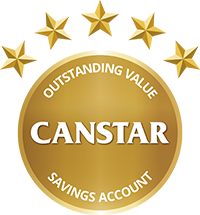Compare Savings Accounts
Compare high interest savings accounts from our Online Partners to find the one that’s right for you. Our table lets you compare account fees, interest rates, Star Ratings and more.

-
For deposit amounts $0 - $250,000
-
For deposit amounts $0 - $5,000,000
-
For deposit amounts $0 - $250,000
No fees overseas from Ubank
Bill Planner to organise your expenses
-
For deposit amounts $0 - $1,000,000
Access money 24/7. No monthly fees. No min balance.
Optional Pay&Save feature. Activate boss mode.
-
For deposit amounts $0 - $100,000
Access money 24/7. No monthly fees. No min balance.
Optional Pay&Save. Savvy Saving Starts Here.
-
For deposit amounts $0 - $100,000
-
For deposit amounts $0 - $100,000
-
For deposit amounts $0 - $100,000
-
For deposit amounts $0 - $250,000
-
For deposit amounts $1 - $250,000
-
For deposit amounts $0 - $5,000,000
-
For deposit amounts over $0
-
For deposit amounts $0 - $1,000,000
-
For deposit amounts $0 - $250,000
-
For deposit amounts over $0
-
For deposit amounts $0 - $100,000
Showing 10 of 124 results
To see more results adjust the filters above
Unsure of a term in the above table? View glossary
The initial results in the table above are sorted by Star Rating (High-Low) , then Maximum variable interest rate p.a (High-Low) , then Provider Name (Alphabetical) . Additional filters may have been applied, which impact the results displayed in the table - filters can be applied or removed at any time.
Better deals are found when you compare
Canstar helps millions of Australians each year compare and find better deals
What is a savings account?

A savings account is a type of bank account that is specifically designed for saving money. You can add money into your savings account and you will typically earn interest on your balance. Interest is usually calculated daily and paid monthly.
Some savings accounts are attached to an everyday transaction account. You can usually access the money in your savings account as needed. In some cases, you may need to transfer money out into your linked transaction account first.
Savings account deposits are protected by the government’s financial claims scheme. This guarantees deposits up to $250,000 in the unlikely event your bank, credit union or building society fails.
What are the different types of savings accounts?
There are a few different types of savings accounts in Australia. This includes bonus savings accounts, promotional savings accounts and age-based savings accounts.
Bonus savings accounts
Bonus savings accounts offer a bonus interest rate if you meet certain conditions each month. Some common conditions include:
- depositing a certain amount of money into your account
- making a certain number of purchases with a linked transaction account
- growing your account
- making no withdrawals.
If you don’t meet the conditions, you will earn the base interest rate only.
Promotional savings accounts
Some providers offer you a higher interest rate for the first few months of having the account, known as the promotional period. After this period ends, the interest rate will drop to the base interest rate only.
Age-based savings accounts
A number of providers offer age-based savings accounts. These accounts offer higher interest rates for younger customers. They are often offered on bonus savings accounts, so you need to meet bonus conditions to earn the maximum interest rate.
There are also youth savings accounts aimed at children, as well as seniors savings accounts designed for pensioners and retirees.
What’s new in savings accounts in July 2025?
- At its February meeting, the Reserve Bank of Australia (RBA) cut the cash rate for the first time in more than four years, lowering it by 25 basis points. The central bank cut rates a second time on Tuesday May 20, with more cuts expected this year.
- Economists at CommBank predict cash rate cuts in July and August, while Westpac predict cuts in August and November. NAB predicts cuts in July, August and November while ANZ predicts just one more cut for 2025, to take place in August.
- When the RBA cuts rates, banks and lenders tend to do the same, so if you want to get the most out of your savings, then you might consider Canstar’s regularly updated list of the best high interest savings accounts in Australia.
- The highest promotional savings account rate on Canstar’s database at the time of writing is 5.15%, which is an introductory rate offered for a promotional period of four months after signup
- The highest base savings account rate on our database at the time of writing is 4.85%
How to compare savings accounts
When comparing savings accounts, you might like to ask yourself questions such as:
- What type of saver are you? Are you a regular saver who is willing to meet stricter savings conditions to get a higher interest rate? Or do you want the flexibility to save without worrying about saving conditions? Canstar compares savings accounts for both types of savers.
- What is the interest rate? The higher the interest rate, the quicker your savings will grow. Look at the base interest rate, as well as any bonus or promotional interest rates.
- What are the fees? Fees can erode your savings, so it’s best to look for a fee-free account. Check whether there is any monthly account fee or transaction fees that apply.
- What are the interest conditions? For bonus savings accounts, check what conditions you need to meet each month. Also check if there is a minimum or maximum balance and whether this impacts your interest rate.
- Are there any useful features? How easy it is to make transactions and manage your savings account can also be important. Some savings accounts also offer budgeting tools, which can be an added bonus.
Canstar compares savings accounts from a range of providers. Our expert researchers use a sophisticated and unique ratings methodology that compares both price and features. The top performing savings accounts are given a 5-Star rating. You can compare savings accounts using our handy comparison tool at the top of this page.
About our finance experts
Josh Sale, Savings Account Ratings Manager
 As Canstar’s Ratings Manager, Josh Sale is responsible for the methodology and delivery of Canstar’s Savings Account Star Ratings and Awards. With tertiary qualifications in economics and finance, Josh has worked behind the scenes for the last five years to develop Star Ratings and Awards that help connect consumers with the right savings account for them.
As Canstar’s Ratings Manager, Josh Sale is responsible for the methodology and delivery of Canstar’s Savings Account Star Ratings and Awards. With tertiary qualifications in economics and finance, Josh has worked behind the scenes for the last five years to develop Star Ratings and Awards that help connect consumers with the right savings account for them.
Josh is passionate about helping consumers get hands-on with their finances. Josh has been interviewed by media outlets such as the Australian Financial Review, news.com.au and Money Magazine.
You can follow Josh on LinkedIn, and Canstar on Twitter and Facebook.
Nina Rinella, Editor-in-Chief
As Canstar’s Editor-in-Chief, Nina heads up a team of talented journalists committed to helping empower consumers to take greater control of their finances. Previously Nina founded her own agency where she provided content and communications support to clients around Australia for eight years. She also spent four years as the PR Manager for American Express Australia, and has worked at a Brisbane communications agency where she supported dozens of clients, including Sunsuper and Suncorp.
Nina has ghostwritten dozens of opinion pieces for publications including The Australian and has been interviewed on finance topics by the Herald Sun and the Sydney Morning Herald. When she’s not dreaming up ways to put a fresh spin on finance, she’s taking her own advice by trying to pay her house off as quickly as possible and raising two money-savvy kids.
Nina has a Bachelor of Journalism and a Bachelor of Arts with a double major in English Literature from the University of Queensland. She’s also an experienced presenter, and has hosted numerous events and YouTube series.
You can follow her on Linkedin, or Canstar on Facebook.
You can also read more about Canstar’s editorial team and our robust fact-checking process.
Important information
For those that love the detail
This advice is general and has not taken into account your objectives, financial situation or needs. Consider whether this advice is right for you.






































